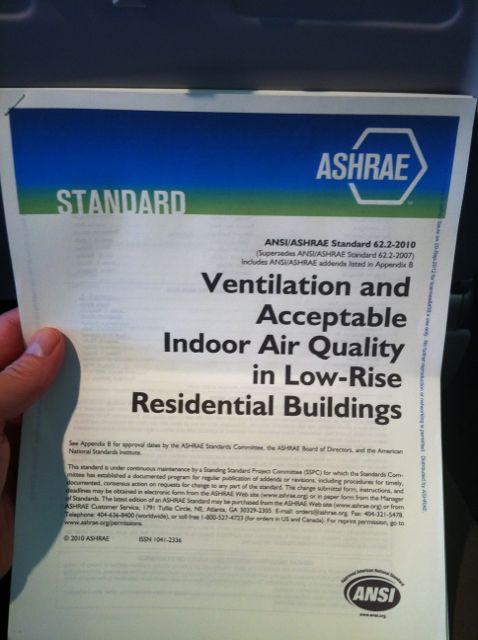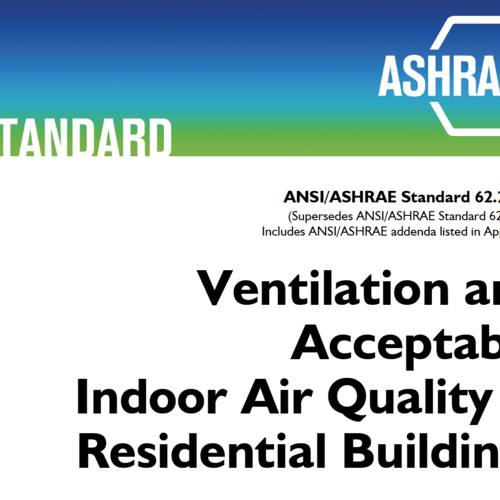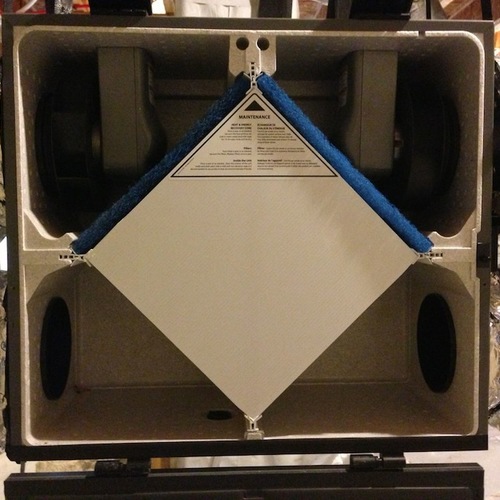Image Credit: Energy Vanguard
Image Credit: Energy Vanguard Dr. Max Sherman and Dr. Joe Lstiburek at the 2014 summer meeting of the ASHRAE 62.2 committee in Seattle
Image Credit: Energy Vanguard
Just because I haven’t written about the jockeying over ventilation rates and strategies with the ASHRAE 62.2 committee doesn’t mean nothing’s going on. If you’ve been following the battle over this issue, you know that Joe Lstiburek, PhD, PE, got fed up with ASHRAE and introduced his own ventilation “standard” in 2013. Then the “Great Ventilation Debate” happened in Detroit, and he got back on the ASHRAE 62.2 committee.
Stuff happened and now RESNET just put an interesting amendment out for public comment. Follow that?
A brief history of the recent battle
Let’s go over the recent history quickly because we want to get to the current state of affairs, right? (Plus I’m on an airplane that will be landing in an hour and then I’ve got to go watch the fireworks with my stepson. No, really. It’s the 4th of July.) So here’s my quick chronology.
- The 2010 version of the residential ventilation standard, ASHRAE 62.2, gets adopted for programs and codes. The simplified version of the rate is 1 cfm per 100 square feet of conditioned floor area (CFA) plus 7.5 cfm per person. (The number of people isn’t the actual number of people; it’s the number of bedrooms plus one.) Everyone’s happy, mostly.
- The 2013 version of ASHRAE 62.2 changes the first part of the calculation. It goes from 1 cfm per 100 square feet of CFA to 3 cfm per 100 square feet. The result is that the total rate nearly doubles. The natives become restless.
- Dr. Joe introduces BSC-01, his ventilation “standard.” (I put that in quotes because it’s not really a standard in the same sense that 62.2 is. There’s no consensus process or public comment behind it. Now that you know that, I’m going to drop the quotes, but you can do air quotes when you read it if you like.) It basically goes back to the 2010 rates of 62.2 but also includes credits to adjust the rate based on the ventilation strategy. The revolution has begun.
- At the 2014 Affordable Comfort conference in Detroit, the Great Ventilation Debate resulted in Dr. Joe becoming a member of the 62.2 committee again. Everyone sings Kumbaya.
Got it? That’s where things were last time I wrote about this issue.
The 62.2 committee discusses rates
In 2014 I started going to the ASHRAE 62.2 committee meetings. The June meeting that year was in Seattle. Joe Lstiburek and Max Sherman spoke to each other, as you can see in the photo below (Image #2), but not much happened at that meeting.
No, the first big move came at the 2015 meeting in Atlanta. There the committee voted on proposals to lower the ventilation rate and give a credit to balanced ventilation. The vote at the meeting was in favor of those proposals, but when absent committee members voted later, the proposals failed.
At the 2016 meeting in St. Louis last month, the committee voted again on lowering the rate. They wanted to take the square footage part of the equation from 3 cfm per 100 square feet of CFA to 2.2 cfm per 100 square feet.
Those in favor of higher rates made various arguments to support their reasoning, but none had any hard evidence behind them. Max Sherman made what I thought was the worst argument: He quoted the first ASHRAE president as saying, “Ventilation is next to godliness.” What he didn’t say was that in the 19th century, medical doctors often advised people to keep their homes closed up because they thought fresh air made people sick, so the big battle then was just to get any ventilation at all.
When the committee voted, the result was 10 in favor of lowering the rate and 8 opposed. The motion failed because it needed a 2/3 majority to pass.
Following that discussion, the committee considered a proposal to give a credit to ventilation systems that distributed the air throughout a home. The vote was similar. A majority voted for the credit, but not a 2/3 majority. It failed, too.
Meanwhile, at the code hearings…
While Lstiburek was trying to get his ideas adopted into the ASHRAE 62.2 standard, he was simultaneously working to get them adopted into the building code. The code hearings have to keep up with their three-year cycle of publishing updated codes. Since the 2015 codes came out, they’ve taken up the issue of ventilation rates.
Through the 2015 IRC, the ventilation rate was set at the ASHRAE 62-1989 rate:
0.35 air changes per hour but not less than 15 cfm/person
Last year at the code hearings, that rate was updated to:
(0.01 cfm/square foot of conditioned floor area) + (7.5 cfm/person)
That’s basically the rate from the 2010 version of ASHRAE 62.2 and Lstiburek’s BSC-01. There’s no acknowledgment of the differences between ventilation strategies, though. It’s the same rate whether you do exhaust-only, supply-only, or balanced.
This change has happened already. It has passed. It will be in the 2018 IRC/IECC.
But there’s another part of the code that needs to be changed to realize the rate change fully. Three years ago, I wrote about something new that appeared in the last code cycle (the codes get updated every three years): The IECC adopted another compliance pathway. It’s a performance, as opposed to prescriptive, path and meeting the code is based on hitting a certain number on what they call the Energy Rating Index (ERI). That index is basically the same thing as the HERS Index and it’s in the 2015 IECC.
But now the building code needs another change if they want the ERI to be calculated using the code-mandated ventilation rate rather than what RESNET says. The code has to make a change even if RESNET adopts the amendment described below because the code language for the ERI points to RESNET’s current standard. So, they’re working to fix that. The language to do so is:
The ERI reference design ventilation rate shall be as specified by Equation 15-1 of Section M1507.3.3 of the International Residential Code.
If it passes, that would mean the ERI will always be calculated based on the ventilation rate specified in the building code, not what RESNET or any other ERI organization specifies.
RESNET’s sticky situation
And now you know how the code change is connected to RESNET through the Energy Rating Index. That ties RESNET to the building codes pretty strongly. Actually, RESNET was bound to the code before the ERI because the HERS reference home is based on the 2004/2006 IECC.
Recently, RESNET sent out a notice of a proposed amendment to the home energy rating standard. The changes mostly have to do with how the ventilation rate is calculated for the reference home, but there are a few other updates in there, too. If you download the proposed amendment, you’ll see that references to the 62.2-2013 rate are struck through and replaced with 0.01 x CFA + 7.5 x (Nbr+1) cfm.
I asked Joe Lstiburek about the amendment, and he sent this response in an email:
RESNET is currently in conflict with the IRC on ventilation. RESNET by referencing ASHRAE is setting a higher ventilation rate than the code. RESNET is in the ratings business, not in the business of setting ventilation rates. If other programs such as Energy Star or LEED want to set a ventilation rate in order to participate in their program, that is up to Energy Star or LEED. And RESNET should rate those houses accordingly. But in terms of rating standard newly constructed houses, RESNET should follow the code.
If RESNET does not adopt this amendment then there is a high likelihood that the proposed IECC code change allowing RESNET to provide an alternative path for code compliance will lose at the Final Action Hearings in Kansas City in October unless the proposed code change is modified to bring it into compliance with the IRC. Building officials do not like third-party groups setting important code changes such as ventilation rates that the building officials do not get to approve as part of their code process.
Additionally, the current language penalizes balanced ventilation in favor of exhaust ventilation. This is a bad precedent. Better ventilation systems are penalized in favor of poor ventilation systems. RESNET raters are aware of this as are builders and both are gaming the ratings system. Balanced system get rating point hits as compared to exhaust-only systems.
He’s right, and there’s an important point in here that often trips people up. I got confused about it myself when I was new to the home energy rating field. A HERS rating is just an analysis. There are no thresholds you have to meet to “pass” anything. It’s supposed to be an objective look at the energy use of a house compared to a “reference home.”
That’s what Lstiburek is saying in the first paragraph above. The reference home, by definition, is supposed to be based on the code. Now that the code and ASHRAE 62.2 have parted ways, RESNET has to make a choice: Do they want to stick with the building code, as they should? Or will they follow a ventilation standard that’s not being used much? I’m in favor of sticking with the code.
If you’d like to learn more about the RESNET amendment or to make a comment, go to the RESNET page for this amendment. Once there, you can read the comments that have already been posted.
Summary
The building code has changed the ventilation rate required in new homes. They’re working on getting the calculation for the ERI based on the new code-required ventilation rate. If RESNET wants the HERS Index to qualify as an ERI, they need to make a change, too. Here are the three scenarios:
- If the code language above gets adopted and RESNET passes its amendment, the ERI will be based on the new IRC ventilation rate and the HERS Index will be the same as the ERI.
- If the code amendment passes but RESNET’s doesn’t, RESNET will have to make changes to calculate the ERI separately from the HERS Index. They might need to have separate calculations anyway for programs and jurisdictions that use different ventilation rates.
- If the code language above does not pass, the ERI path probably won’t be as appealing to builders because they’ll take a hit in ERI points for meeting code instead of ASHRAE 62.2-2013.
Isn’t it fun to get into the world of ventilation standards and codes! But guess what? This isn’t new. Here’s a quote from the book Ventilation and Heating by John Shaw Billings, M.D.:
“It is in the determination of [the ventilation rate] that the young architect or engineer is likely to find his chief difficulties, owing to the great divergence of opinion among the authorities to whom he will probably refer for guidance.”
That was written in 1893. As it says in the Bible, there’s nothing new under the sun.
Allison Bailes of Decatur, Georgia, is a speaker, writer, building science consultant, and the author of the Energy Vanguard Blog. Check out his in-depth course, Mastering Building Science at Heatspring Learning Institute, and follow him on Twitter at @EnergyVanguard.
Weekly Newsletter
Get building science and energy efficiency advice, plus special offers, in your inbox.
















2 Comments
automatic updates
Can I connect my new ventilation system to the internet and have it automatically change ventilation rates when the standard changes?
More seriously, the lack of consensus tempts me to shop for one of the many new air quality monitoring systems.
Houses are Dumb without Smart Ventilation
Thanks for the update Allison! What irks me about all of this that what really matters is what is the indoor air quality (IAQ) and comfort at any given moment in time. We now have affordable technology (sensors and smart ventilation systems like the CERV by Build Equinox) that tells us when to ventilate for biological reasons (to reduce CO2 and VOC levels), when to ventilate for energetic reasons (bring in cooler air at night during the cooling season), and when to re-circulate for both reasons (mixing the air throughout the building to take advantage of fresh air pockets in unoccupied spaces w/o expending energy on fresh air ventilation. Models predicting what is healthy and efficient based on air changes per hour or CFM do not cut the mustard. See, 'Houses are Dumb without Smart Ventilation' by Berkeley Labs (LBNL)
http://escholarship.org/uc/item/22m9243j#page-1
Log in or create an account to post a comment.
Sign up Log in